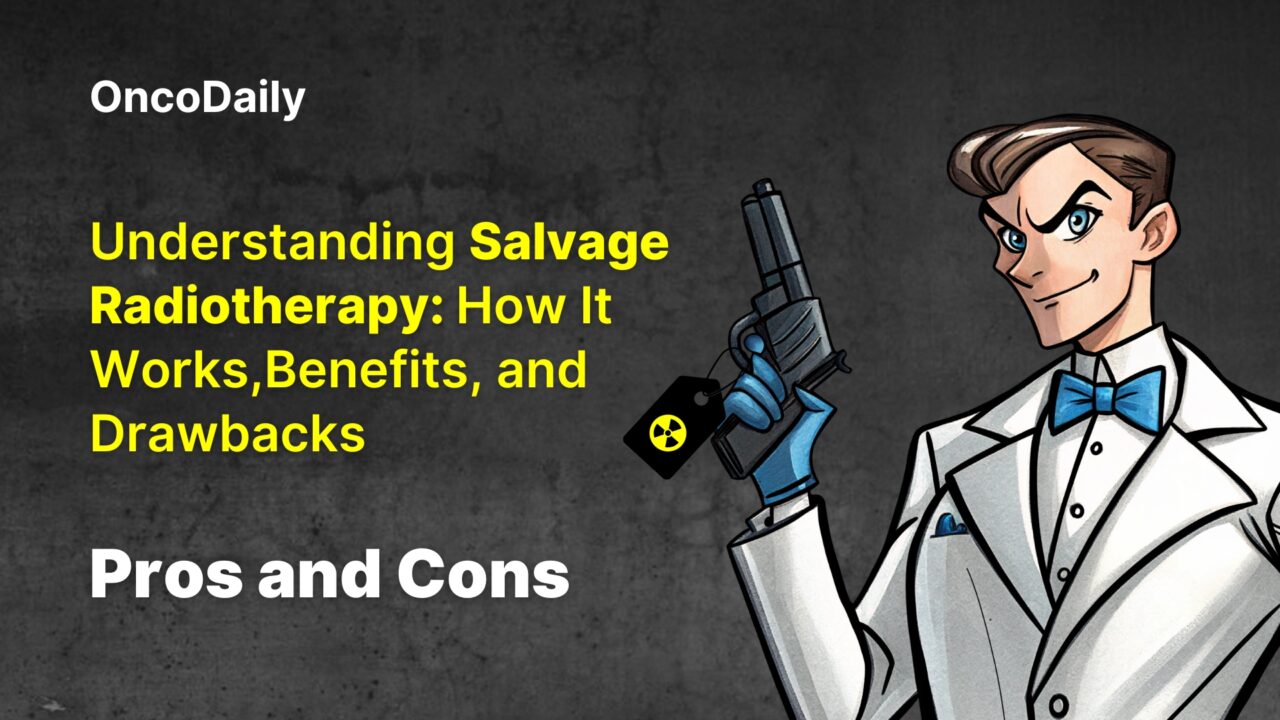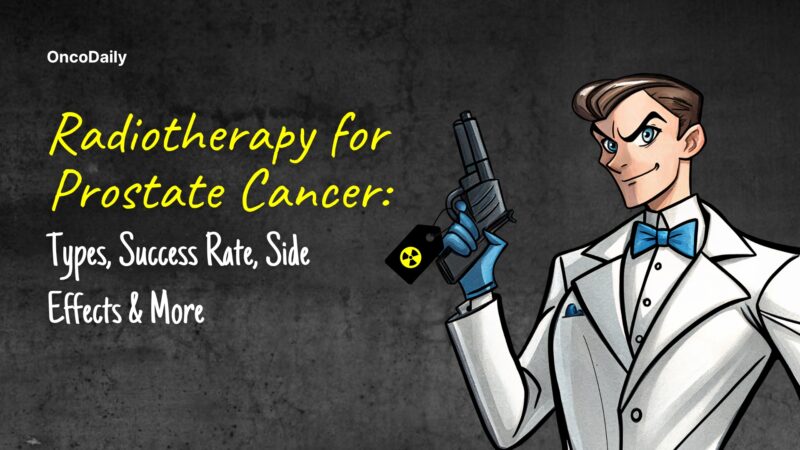
Understanding Salvage Radiotherapy: How It Works, Benefits, and Drawbacks
Salvage radiotherapy is a key treatment option for men experiencing a recurrence of prostate cancer after initial therapy, such as surgery. Unlike primary radiation therapy, which targets the cancer during its first appearance, salvage radiotherapy is used when the cancer returns—often detected through rising PSA levels. This approach aims to eliminate remaining cancer cells and prevent further spread. In this brief overview, we’ll explore how salvage radiotherapy works, why it’s important, and weigh its potential benefits and limitations.
What Is Salvage Radiotherapy?
Salvage radiotherapy (SRT) is a second-line cancer treatment used primarily for patients who experience a recurrence of cancer—such as biochemical relapse of prostate cancer—after undergoing initial curative treatment like radical prostatectomy (surgical removal of the prostate) or, in some cases, prior radiation therapy.
Its main goal is to target and eliminate residual cancer cells that were not detected or completely removed during the initial treatment. This is particularly important in cases where prostate-specific antigen (PSA) levels begin to rise again after surgery—a sign of biochemical recurrence (BCR)—even if no cancer is visibly detected on imaging.
SRT is considered a second-line or “salvage” therapy because it is applied after the primary treatment has failed to fully control the cancer. It is not part of the initial treatment plan but becomes necessary when there’s evidence that the cancer might be returning.
What Are the Main Types of Salvage Radiotherapy?
Salvage radiotherapy (SRT) for recurrent prostate cancer can be classified into several types based on timing, dosage and field size, combination with other treatments, and treatment modalities. Tailoring these factors helps optimize outcomes and reduce side effects for patients experiencing biochemical recurrence after prostatectomy.
Timing-Based Classification
I referenced the study you shared, where early salvage radiotherapy (initiated at PSA 0.2–0.5 ng/mL) was the most significant predictor of improved outcomes, specifically bRFS and MFS (hazard ratios HR = 0.52 and HR = 0.58, respectively).
Dosage and Field Size
Your earlier text mentioned high-dose salvage RT (e.g., 70.2 Gy), and that most series use lower doses compared to primary RT, helping keep toxicity lower.
Combination with Other Therapies
The study noted that 32.6% of patients received neoadjuvant or concurrent androgen deprivation therapy (ADT).
Treatment Modalities
While your texts didn’t go into depth on external beam radiation therapy (EBRT) versus other modalities, the mention of prostate bed-only radiotherapy and hypofractionated RT helped guide this part.
When Should Salvage Radiotherapy Be Initiated?
The evidence from the provided texts strongly suggests that SRT should be initiated when the PSA level is low, ideally below 1.0 μg/L and even better when it is 0.5 μg/L or less. While PSADT is an important prognostic factor, the PSA level at the time of initiation appears to be a key determinant of outcome. Guidelines, such as those from the European Association of Urology, recommend considering SRT at PSA levels up to 1.5 μg/L. The overall consensus from the provided texts points towards earlier intervention at lower PSA levels for potentially better outcomes.
In a 2007 publication in The Journal of Urology, Howard M. Sandler and Mario A. Eisenberger noted that a rising PSA (0.2-0.4 ng/ml) after radical prostatectomy indicates recurrence. While restaging is advised, metastases are often not detectable at low PSA. Local therapy is most effective for slow PSA increases (<1.0 ng/ml) and lower Gleason scores, suggesting localized recurrence. Approximately 70% of patients with biochemical relapse are unlikely to die from the disease but remain at risk for metastasis and morbidity. Currently, there’s no consensus on standard systemic treatment, making clinical trial participation a priority.
Side Effects of Salvage Radiotherapy: What to Expect?
While salvage radiotherapy (SRT) is a crucial treatment for controlling recurrent prostate cancer after surgery, it’s important for patients to understand that they may experience certain side effects. These side effects can vary depending on individual factors such as the dose of radiation, the area being treated, and the patient’s overall health.
Genitourinary (GU) Side Effects
Genitourinary (GU) Side Effects (Related to the Urinary System): Urine issues are common and can include blood in your urine (hematuria), pain or burning sensation when passing urine (dysuria), increased frequency of urination (needing to go more often), increased urgency to urinate (feeling a sudden need to go), less control of urine (urinary incontinence), and scar tissue in your urethra (urethral stricture), which can cause difficulty passing urine. Studies have reported that some patients may experience longer-term urinary issues, with grade 2 or higher late GU toxicity occurring in around 11% of patients at 5 years . This can include issues like stenosis (narrowing) of the urethra or bladder neck.
Braide et al. reported in the 2020 Scandinavian Journal of Urology that at a median 10-year follow-up after surgery, patients receiving SRT had a 1.2 to 1.4 times higher relative risk of urinary symptoms compared to those who had only radical prostatectomy. The study concluded that SRT generally results in acceptable long-term side effects, although a subset of men may develop severe issues.
Gastrointestinal (GI) Side Effects
Gastrointestinal (GI) Side Effects (Related to the Bowel): Bowel issues can include loose stools (diarrhea), blood in your stool (rectal bleeding), and proctitis, which is inflammation of the rectum potentially causing discomfort. These side effects are often mild to moderate. Longer-term bowel issues (grade 2 or higher) have been reported in a smaller percentage of patients, around 4.7% in one study.
Sexual Side Effects
Based on the texts provided, the main sexual side effect mentioned in relation to salvage radiotherapy (SRT) is problems with erections, also known as erectile dysfunction. One of the texts also mentions that a quality of life study found that the group of patients treated with SRT reported worse outcomes in sexual function compared to those who did not have a recurrence after radical prostatectomy, suggesting a broader impact on sexual health beyond just erectile function. However, the texts do not offer extensive details on the specifics of these sexual side effects, which can vary among individuals depending on factors like pre-treatment function, radiation extent, individual health, and the use of hormone therapy.
Zwahlen et al. reported in the 2024 Clinical and Translational Radiation Oncology journal that 57.3% of patients had mild to moderate erectile dysfunction (ED) after radical prostatectomy, while 42.7% had severe ED. Five years after salvage radiotherapy (sRT), 29.4% reported mild to moderate ED. Dose intensification of sRT (70Gy vs 64Gy) showed no significant impact on erectile function recovery or new ED.

Read OncoDaily’s Special Article About Prostate Radiotherapy
Reducing the Risk of Long-Term Side Effects
Comparison: Salvage Radiotherapy vs. Adjuvant Radiotherapy
FAQ
What is Salvage Radiotherapy (SRT)?
SRT is radiation therapy given after prostate surgery (radical prostatectomy) when the prostate-specific antigen (PSA) level rises again, indicating the cancer has recurred.
When should SRT be started?
Ideally, SRT should be started when the PSA level is low, preferably under 1.0 μg/L and even better below 0.5 μg/L.
What are the common side effects of SRT?
Common side effects include bowel issues (loose stools, blood in stool), urine issues (blood in urine, pain, frequency, incontinence), and sexual issues (erection problems).
What are the benefits of SRT?
SRT aims to control local recurrence, prevent or delay the spread of cancer, and can improve progression-free and overall survival, especially when started early
How does SRT differ from adjuvant radiotherapy?
Adjuvant RT is given shortly after surgery to high-risk patients to prevent recurrence, while SRT is given later if PSA rises.
Does SRT improve survival rates?
Yes, studies show SRT can improve progression-free survival, and combining it with hormone therapy can improve overall survival.
How much does SRT cost?
The cost varies depending on treatment duration, techniques used, facility charges, and insurance coverage. It's best to check with your healthcare provider and insurance.
What is the recovery like after SRT?
Recovery involves managing potential side effects, gradually returning to activities, and attending regular follow-up appointments for PSA monitoring.
How can long-term side effects of SRT be minimized?
Regular follow-ups, adherence to care plans, healthy lifestyle choices, and prompt reporting of symptoms can help minimize long-term side effects.
How effective is SRT?
The effectiveness of SRT is best when started at low PSA levels, with 5-year biochemical progression-free survival rates varying from 35% to 85% depending on PSA at initiation.
-
Challenging the Status Quo in Colorectal Cancer 2024
December 6-8, 2024
-
ESMO 2024 Congress
September 13-17, 2024
-
ASCO Annual Meeting
May 30 - June 4, 2024
-
Yvonne Award 2024
May 31, 2024
-
OncoThon 2024, Online
Feb. 15, 2024
-
Global Summit on War & Cancer 2023, Online
Dec. 14-16, 2023
